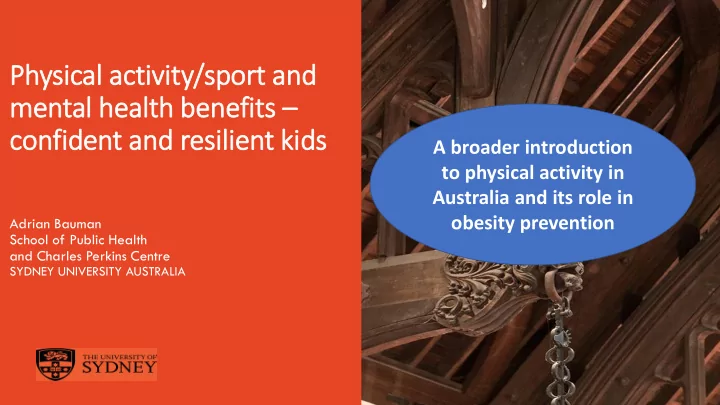

Physical activ ivity/sport and mental health benefits – confident and resilient kid ids A broader introduction to physical activity in Australia and its role in obesity prevention Adrian Bauman School of Public Health and Charles Perkins Centre SYDNEY UNIVERSITY AUSTRALIA
But first – a definition What is ‘physical activity’ • ‘exercise’ • Sport • Physical activity 2
What is children’s PA? • Structured – Sport and PE: rules; may need location/equipment; training, skills development • Un-structured (non- organised) – free PLAY! • Active transport (walking, cycling, scooting etc.) to get to places
THE NEW WHO GLOBAL ACTION PLAN ON PHYSICAL ACTIVITY 2018 – 2030 #GAPPA #BEACTIVE
RIS ISKS OF PHYSICAL IN INACT CTIVITY – in independent effects in in it its ignificant cont ntrib ibuto utor r to to ob obesity ity own rig ight as well ll as a sig Clear reasons for “getting Australia more active” 4 TH LEADING RISK FACTOR FOR GLOBAL MORTALITY, WHO 2009; Lancet PA series 2012 9
Benefits of f PA for chil ildren Develop the lifelong habit of being active Social skills and integration, reduce isolation Long term chronic disease prevention
How are we doing in physical activity in Australia overall ?
Some “disconnections” emerged for me between PA research and policy outputs Consider the Global Atlas of physical activity : GoPA ! http://www.globalphysicalactivityobservatory.com/ The University of Sydney Page 15
Page 13 The University of Sydney
Page 14 The University of Sydney
Australia Low active population High research output No physical activity plan The University of Sydney Page 18
Australia – the land of disconnect … PUBLISHING Low active population RESEARCH PREVALENCE High research output No physical activity plan Page 16 POLICY The University of Sydney
22 year trends in leisure-time physical activity in Australian Chau J, et al 2017 ANZJPH adults comparable NHS national surveillance data, 1989-2011
Trends in prevalence of sufficient physical activity Overall fitted trend for years: OR = 0.998; p=0.012 Interpretation: There was a 0.2% decrease per year over 22 years in prevalence of sufficient physical activity
Trends in physical inactivity [low-nil activity] Overall fitted trend for years: OR = 0.999; p=0.242 Interpretation: No change over 22 years in prevalence of inactivity
NO DEFINED SYSTEM OF PHYSICAL ACTIVITY MONITORING FOR CHILDREN AND ADOLESCENTS IN AUSTRALIA Physical activity guideline : at least 60 mins/day of moderate-vigorous physical activity
Australian kids PA report card 2018
International report card on Children’s PA levels, programs and policies, 2018
If we think of obesity as the result of energy imbalance…. Energy Energy expended Input [total PA] [food] Likely Likely eating expending less ? more
ROLE IN OBESITY PREVENTION Diet OR physical activity in weight loss and weight loss maintenance ? • Diet most important ?? 2/3 of the solution is dietary modification / restriction/ regulation • Physical activity important ? 1/3 of the solution • But physical activity improves metabolic health at any weight [even in the absence of weight loss]
CONCLUSIONS 1. Australia needs a standalone PA plan, resourced implementation strategy 2. Subsuming PA under obesity strategies never realises sustained change in the cross- agency work required to make a more “Active Australia” 3. The National Sport Policy is a start, but only relates to one sector 4. Leadership, taskforce, national steering processes with imprimatur to act remain absent for physical activity 5. Offering a short term strategy is not delivering a longterm solution 6. Only integrated and substantial effort on activating Australians would contribute to obesity prevention in meaningful ways
Recommend
More recommend